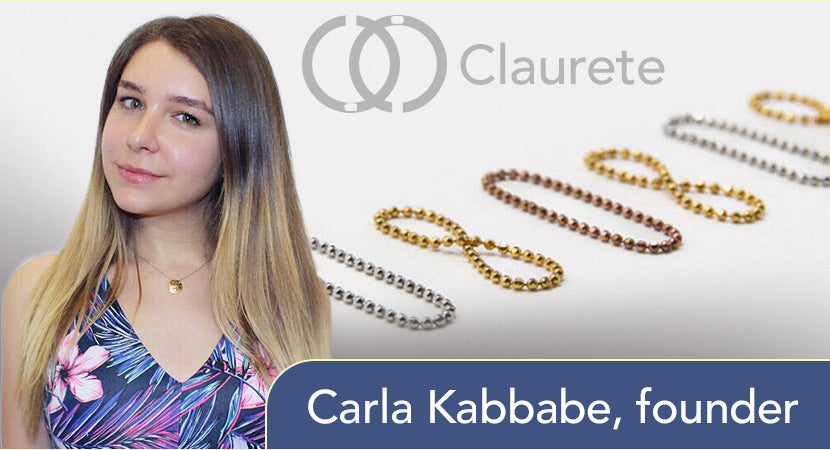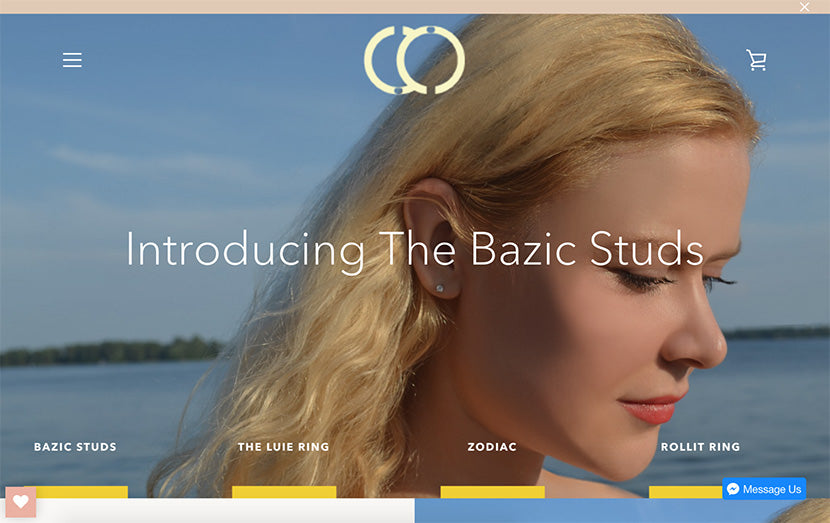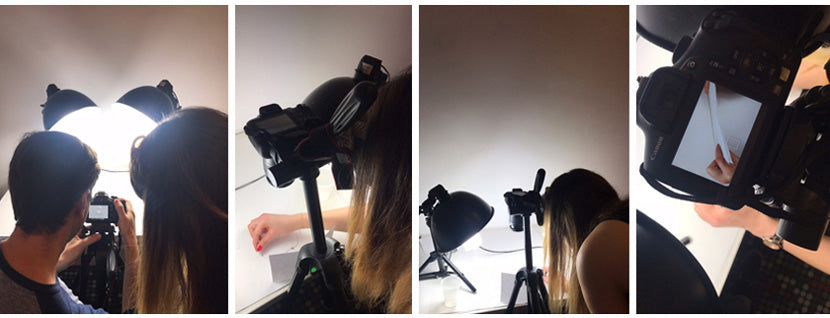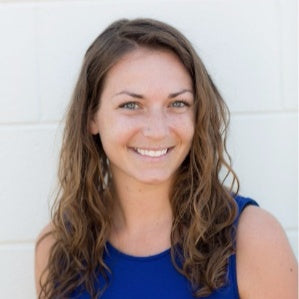Product photography is so important to ecommerce brands. Almost everyone you ask does it differently.
Some retailers outsource everything, hiring a freelance photographer or even shipping products off to a company like Products on White Photography. Others bring everything in-house, building their own internal photography department.
And others still fall somewhere in between — maybe taking their own shots and outsourcing the photo editing, or hiring a freelance photographer for occasional product shoots.
All of these options have made us curious, and I've set out to talk to as many ecommerce brands as I can to find out exactly how they create the product photos that promote their products.
That's when I connected with Carla Kabbabe, founder of Toronto-based high-end jewelry brand Claurete. Kabbabe has successfully built her brand and loyal customer base on their Shopify website, prioritizing owned channels over third-party marketplace selling. Let's take a look at how she put together her photography team, how they manage shoot day, and what successful product images look like at Claurete.

Developing the brand
Kabbabe used Shopify's user-friendly website builder, which made it easy for her to find a theme with a visual aesthetic that matched the look she was going for. "We're high-end, but we're also a fun brand," she says. "It's not too traditional."
But Kabbabe knew that she needed more than a nice website design to convey the message of her brand to customers. She needed photography that complemented that casual-meets-luxury identify of Claurete. At first, Kabbabe didn't have the team in place with the skills to pull off a brand photoshoot. She knew she needed to enlist some expertise, first trying to outsource the photography but then deciding to move it in-house. "It wasn't so easy to communicate back and forth, because we were still trying to figure out the details behind the photos, and how we're going to translate to the consumers that this is what we do," she says. So Kabbabe set out to build her own creative team to bring the brand to life, hiring a team of marketers with backgrounds in photography. When Kabbabe initially set out to assemble an internal team, she looked within her network. "Because I've been in fashion for a while, I was lucky enough to build my network within that niche," she says. "Having that really helped me know who I wanted to work with." That's how she found her first hires: a marketer, social media specialist and photographer.
But it wasn't ALL as easy as that. She also went the recruiting route, posting job ads and vetting candidates. The combination of talent-seeking approaches helped Kabbabe put together a talented, creative, and collaborative group of professionals. Kabbabe says it was key to find marketing professionals who also had some sort of photography background. Having a background in photography herself, this makes it easy for the team to communicate and stay on the same page. "It was easy for me to use the language that most photographers use," she says. She also recommends having an open mind when hiring talent. "I wasn't so picky because I understand if someone is earlier in their career, but I know they're talented and going to excel in the future, I can be patient," she says. Teams aren't always perfect from Day 1, sometimes you need to develop your team as a leader.
However, she notes that if you're on a tight deadline, you might not have time to mentor talent. In that case, she recommends looking for more qualified freelance professionals. After Kabbabe had a solid team in place, she set sights on their first shoot together. They rented a studio space which supplied lighting equipment, and brought their own DSLR camera and tripod. Prior to the shoot, Kabbabe drafted a plan to make the day go as smoothly as possible. She created a vision board to communicate her creative goals with the team in a simplified way. The vision board told the story she wanted to convey for each collection, reiterated the Claurete brand identity, and set the stage for the overall look and feel of every image. To make your own vision board, Kabbabe recommends having a creative brainstorm and considering what the brand message is that you want to tell. The first shoot, held both indoors and outdoors, was also made possible thanks to the hired assistant. This person was key in guiding the placement of the jewelry for each shot, Kabbabe says. "Because we're working with jewelry, it's easy to get shadows in the shots." The assistant helped mitigate these effects while Kabbabe and her team focused on the creative. Now, Kabbabe and her team have multiple photoshoots every year. "It depends on how many collections we want to launch," she says. In 2017, they have 24 shoots. "This wasn't all related to the jewelry," Kabbabe points out. Claurete launched six collections, and had 12 photoshoots focused on product shots. "Each collection had two themes that we were going for." "Have a futuristic sense of how you're going to get this done," Kabbabe says. She recommends thinking of everything — including location, weather, the timeline, models, the products, etc. And don't leave your shoots until last minute. Shoot the collections months in advance of their launch so you have time to repurpose the assets and build your promotion plans. Expect the best, and plan for the worst — it's an adage that rings true here as well. Kabbabe mentioned a recently scheduled photoshoot that had to be canceled because of snowstorm and subzero temperatures. You can't control the weather, so it's best to have contingency plans in place should your original not pan out the way you thought. "Working with that mindset help you eliminate the chances of something going wrong and makes it easier for you to get the most out of the photoshoot." On the note of maximizing your resources, Kabbabe also recommends asking photographers to take multiples of each product — it's better to have too much to work with than not enough. "When I know that the photographer is good, I always ask them to take multiple shots in different settings," she says. Yes, the photoshoot is all about the products, but you can't forget about the people who are making it possible. Kabbabe kicks things off with clear communication with the entire team involved on shoot day, including a written schedule and plan to supplement the vision board. She also says it's important to take care of your team, alluding to one beach photoshoot on a hot day for which she had to get plenty of water in advance. "It's simple stuff like that, making sure everyone's health and wellbeing is taken care of, that really makes a difference." Remember to give staff breaks when they need it, and offer just enough guidance to make the day go smoothly without micromanaging.
After shoot day's wrapped, Kabbabe and her team have to cull and edit the images. They start with eliminating any shots they know they won't use, so they don't spend any time or resources on prepping those files any further. Basic edits are minimal. "We don't overproduce the photos because we want the consumer to see the jewelry for what it really is," she says. Claurete's goal is to represent the jewelry accurately through product photography, so customers receive a product that meets their expectations. They also have the occasional retouching job to clean up images and remove anything floating in the background that's not meant to be there. Kabbabe and her team use a shared Gmail account so everyone can access the files wherever they are. They organize the shots by date, project, and the name of the photographer so everyone can quickly and easily find what they need.
"This makes things organized, even if there is back and forth," says Kabbabe. "We've tried so many different ways of organizing the photos, and this has been the best way for us." Facebook and Instagram are two key pillars to Claurete's digital marketing strategy, and they also maintain a presence on Twitter, Pinterest, and YouTube. Because everyone has access to the files, various team members can easily find what they need and resize the photo for use on social media.
They also lay out the various images they plan to use on social to make sure there's a cohesive look and feel. Then they schedule the posts through Buffer. One question I always love to ask ecommerce brands is, "How do you know your product photos are effective in engaging your audience and converting users?" At Claurete, they look at a number of indicators. "We look at the reach or impressions on Instagram," Kabbabe says. "And if people are interacting positively, commenting, tagging their friends, or liking the post." They also go the extra mile to solicit direct feedback from customers. "We're very focused on the consumer," she says. "Before we even launch any product, we normally have a chat with our customers and ask them to take a survey about each piece." That helps them assess whether the design will be a hit, and then once the shots have been taken, they survey again. "We ask people what they think about the photos and if they get a sense that it's high-end," she says. "If they say yes, that means the job was done well, because that's what we want to convey." To Claurete, accurately representing the brand and products means success. "It's first thing in the ecommerce: If you don't have good photos, what do you have?" she says. "I've realized the importance of taking good shots, and I'm glad that you're able to see that through Claurete's photos." For more product photography resources, check out these articles:
Shopify made things really easy with the whole theme. I'm a big fan of Shopify. – Carla Kabbabe, founder, Claurete

Building an in-house product photography team
In business, you have to have the mindset that not everyone is going to have the perfect set of experiences. – Carla Kabbabe, founder, Claurete
How Claurete manages photoshoots

Kabbabe's tips for your next product photoshoot
Think ahead
Have a backup plan
Get the most out of your shoot

Remember the people
You can see how the models are having fun in the shots. – Carla Kabbabe, founder, Claurete
Post-shoot processes at Claurete
Editing the product photos

Organizing and sharing photos
Repurposing photos for social media
Understanding the photos' effectiveness
Moving forward with your product photography


